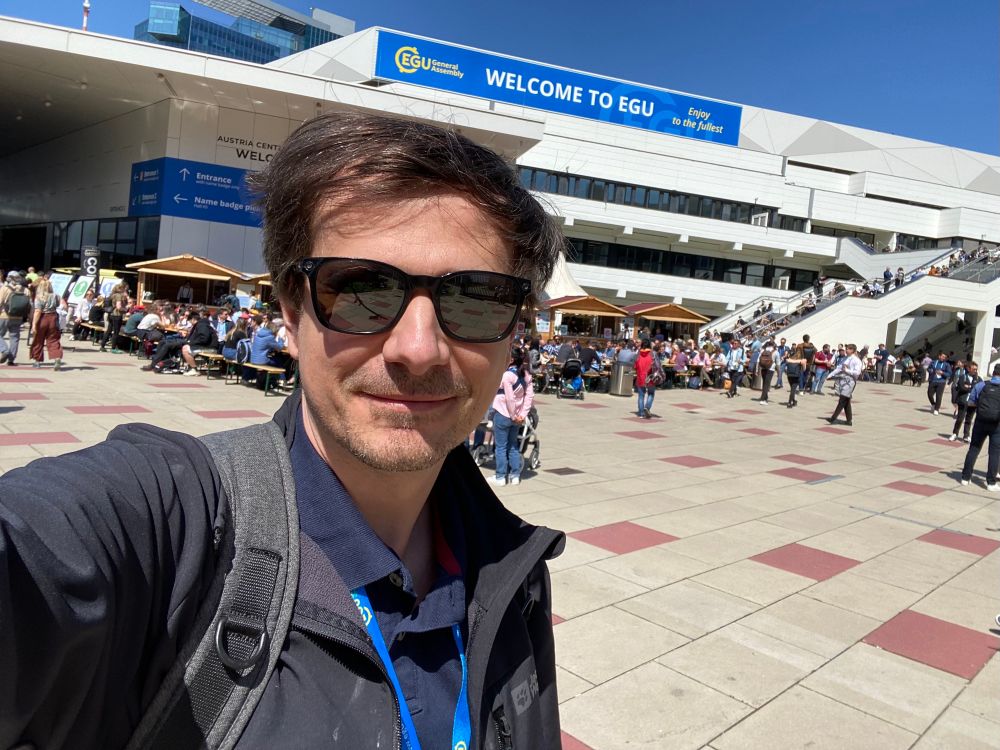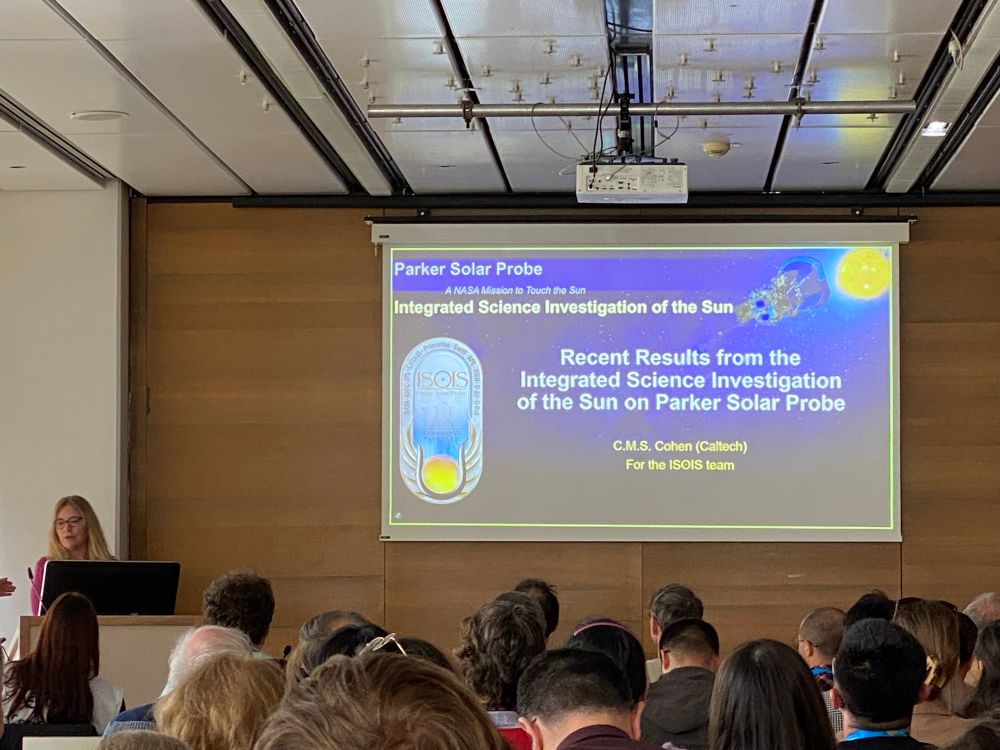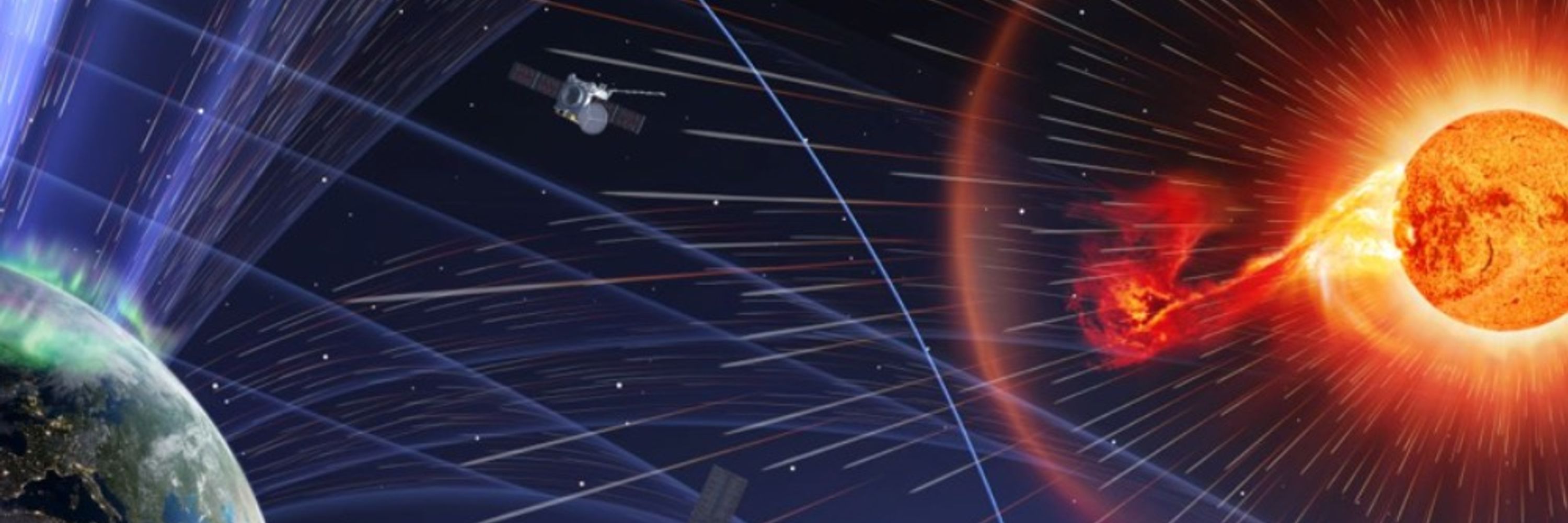
Christian Möstl
@chrisoutofspace.bsky.social
Heliophysicist | Head, Austrian Space Weather Office @aswogeosphere.bsky.social | GeoSphere Austria https://geosphere.at/en/topics/disaster-protection/space-weather |☀️💥💨🌍 | erc.europa.eu HELIO4CAST | http://helioforecast.space | he / him
A new podcast (in german) is available on all platforms with Hannah Rüdisser @hannahruedisser.bsky.social and me talking about many aspects of space weather, like future @esaspaceweather.esa.int missions, Miyake Events and solar storm impacts on technology.
👇
geosphere.at/de/aktuelles...
👇
geosphere.at/de/aktuelles...

Folge 10: Die stürmische Seite der Sonne
Achtung! Achtung! Das ist eine Sturmwarnung aus dem Weltall! Ganz so wild geht es im Arbeitsalltag der beiden Astrophysiker:innen Christian Möstl und Hannah Rüdisser zwar nicht (immer) zu, aber sie ha...
geosphere.at
November 5, 2025 at 12:36 PM
A new podcast (in german) is available on all platforms with Hannah Rüdisser @hannahruedisser.bsky.social and me talking about many aspects of space weather, like future @esaspaceweather.esa.int missions, Miyake Events and solar storm impacts on technology.
👇
geosphere.at/de/aktuelles...
👇
geosphere.at/de/aktuelles...
Day 4 of #ESWW2025! @maikebauer.bsky.social + @lelouedecj.bsky.social presented posters on #solarstorm automatic detection and modeling to make life easier for forecasters. @hannahruedisser.bsky.social took part in a panel on the best practices and future use of AI in #spaceweather! 1/3




October 31, 2025 at 7:58 AM
Day 4 of #ESWW2025! @maikebauer.bsky.social + @lelouedecj.bsky.social presented posters on #solarstorm automatic detection and modeling to make life easier for forecasters. @hannahruedisser.bsky.social took part in a panel on the best practices and future use of AI in #spaceweather! 1/3
Day 3 at #ESWW2025! @hannahruedisser.bsky.social presented our automatic solar storm detection method ARCANE, combined with our models for the storm magnetic field (3DCORE) and arrival time (ELEvo), showcasing their power for real time application. (1/2)👇




October 29, 2025 at 1:10 PM
Day 3 at #ESWW2025! @hannahruedisser.bsky.social presented our automatic solar storm detection method ARCANE, combined with our models for the storm magnetic field (3DCORE) and arrival time (ELEvo), showcasing their power for real time application. (1/2)👇
Day 2 at #ESWW2025! @spacedavies.bsky.social rocked the stage with a talk on solar storm forecasts with sub-L1 monitors with @esa.int #SolarOrbiter. I participated in 2 panel discussion, on the role of validation, and the future of space weather modeling at ESA in the next 10-15 years. ☀️💥🤖




October 29, 2025 at 8:02 AM
Day 2 at #ESWW2025! @spacedavies.bsky.social rocked the stage with a talk on solar storm forecasts with sub-L1 monitors with @esa.int #SolarOrbiter. I participated in 2 panel discussion, on the role of validation, and the future of space weather modeling at ESA in the next 10-15 years. ☀️💥🤖
Some impressions from day one at #ESWW2025 including first poster presentations and big congrats to long-time collaborator Erika Palmerio @erikapal.bsky.social for receiving the Alexander Chizhevsky Medal for early career scientists!




October 27, 2025 at 4:56 PM
Some impressions from day one at #ESWW2025 including first poster presentations and big congrats to long-time collaborator Erika Palmerio @erikapal.bsky.social for receiving the Alexander Chizhevsky Medal for early career scientists!
🇬🇧UK Space Weather meeting in Sheffield, day 3 starts with a session on new 🛰️ missions, including @craig.deforest.org on @punch-mission.bsky.social, Jorge Amaya on a new fleet of @esa.int spacecraft and a possible later far-side ☀️ mission (near L3), and Jonathan Eastwood on ESA HENON for sub-L1 data.




September 10, 2025 at 8:25 AM
🇬🇧UK Space Weather meeting in Sheffield, day 3 starts with a session on new 🛰️ missions, including @craig.deforest.org on @punch-mission.bsky.social, Jorge Amaya on a new fleet of @esa.int spacecraft and a possible later far-side ☀️ mission (near L3), and Jonathan Eastwood on ESA HENON for sub-L1 data.
Some impressions from the UK 🇬🇧💂♂️ Space Weather and
Space Environment Meeting III in Sheffield this week - I talked about research to operations to research at @aswogeosphere.bsky.social and the usage for spacecraft measuring solar storm magnetic fields closer to the Sun ☀️ (so called sub-L1 monitors).
Space Environment Meeting III in Sheffield this week - I talked about research to operations to research at @aswogeosphere.bsky.social and the usage for spacecraft measuring solar storm magnetic fields closer to the Sun ☀️ (so called sub-L1 monitors).




September 9, 2025 at 8:55 AM
Some impressions from the UK 🇬🇧💂♂️ Space Weather and
Space Environment Meeting III in Sheffield this week - I talked about research to operations to research at @aswogeosphere.bsky.social and the usage for spacecraft measuring solar storm magnetic fields closer to the Sun ☀️ (so called sub-L1 monitors).
Space Environment Meeting III in Sheffield this week - I talked about research to operations to research at @aswogeosphere.bsky.social and the usage for spacecraft measuring solar storm magnetic fields closer to the Sun ☀️ (so called sub-L1 monitors).
This #solarstorm from late Aug 30 2025 will arrive at 🌍 noon to late Monday Sep 1.
Depending on its internal magnetic field, it has the potential for #aurora in central Europe and maybe #GNSS errors.
Parker Solar Probe will tell us in hindsight if its field was predictable from 0.5 au.
Depending on its internal magnetic field, it has the potential for #aurora in central Europe and maybe #GNSS errors.
Parker Solar Probe will tell us in hindsight if its field was predictable from 0.5 au.

August 31, 2025 at 3:40 PM
This #solarstorm from late Aug 30 2025 will arrive at 🌍 noon to late Monday Sep 1.
Depending on its internal magnetic field, it has the potential for #aurora in central Europe and maybe #GNSS errors.
Parker Solar Probe will tell us in hindsight if its field was predictable from 0.5 au.
Depending on its internal magnetic field, it has the potential for #aurora in central Europe and maybe #GNSS errors.
Parker Solar Probe will tell us in hindsight if its field was predictable from 0.5 au.
The new AI foundation-type model, based on Solar Dynamics Observatory data, arxiv.org/abs/2508.141...
is also featured @wired.com
www.wired.com/story/ibm-an...
is also featured @wired.com
www.wired.com/story/ibm-an...

IBM and NASA Develop a Digital Twin of the Sun to Predict Future Solar Storms
The tool models the sun using AI, and its developers say it can anticipate solar flares 16 percent more accurately and in half the time of current prediction systems.
www.wired.com
August 25, 2025 at 1:49 PM
The new AI foundation-type model, based on Solar Dynamics Observatory data, arxiv.org/abs/2508.141...
is also featured @wired.com
www.wired.com/story/ibm-an...
is also featured @wired.com
www.wired.com/story/ibm-an...
This is a really great summary of the current state of #AI.
For my scientific work 🧑💻 its useful to (1) quickly summarize fields that I am not familiar with and (2) to give me templates for coding.
Both are great tools ⚒️ but a far cry from AGI/ASI.
www.theatlantic.com/technology/a...
For my scientific work 🧑💻 its useful to (1) quickly summarize fields that I am not familiar with and (2) to give me templates for coding.
Both are great tools ⚒️ but a far cry from AGI/ASI.
www.theatlantic.com/technology/a...

AI Is a Mass-Delusion Event
Three years in, one of AI’s enduring impacts is to make people feel like they’re losing it.
www.theatlantic.com
August 19, 2025 at 11:28 AM
This is a really great summary of the current state of #AI.
For my scientific work 🧑💻 its useful to (1) quickly summarize fields that I am not familiar with and (2) to give me templates for coding.
Both are great tools ⚒️ but a far cry from AGI/ASI.
www.theatlantic.com/technology/a...
For my scientific work 🧑💻 its useful to (1) quickly summarize fields that I am not familiar with and (2) to give me templates for coding.
Both are great tools ⚒️ but a far cry from AGI/ASI.
www.theatlantic.com/technology/a...
Reposted by Christian Möstl
WELCOME TO THE FAMILY, ALPHA CEN A b!!!
First hinted at in Wagner+21, now Chas Beichman, Aniket Sanghi and team have published new JWST images of alpha Cen A showing another hint of this Saturn-sized planet candidate!
exoplanetarchive.ipac.caltech.edu/overview/alp...
First hinted at in Wagner+21, now Chas Beichman, Aniket Sanghi and team have published new JWST images of alpha Cen A showing another hint of this Saturn-sized planet candidate!
exoplanetarchive.ipac.caltech.edu/overview/alp...

August 7, 2025 at 5:25 PM
WELCOME TO THE FAMILY, ALPHA CEN A b!!!
First hinted at in Wagner+21, now Chas Beichman, Aniket Sanghi and team have published new JWST images of alpha Cen A showing another hint of this Saturn-sized planet candidate!
exoplanetarchive.ipac.caltech.edu/overview/alp...
First hinted at in Wagner+21, now Chas Beichman, Aniket Sanghi and team have published new JWST images of alpha Cen A showing another hint of this Saturn-sized planet candidate!
exoplanetarchive.ipac.caltech.edu/overview/alp...
This years @erc.europa.eu Advanced Grant results are out! In solar system sciences and #heliophysics there are projects on solar coronal heating, stellar convection and icy moons.
Otherwise in #astrophysics topics like planet formation, black holes and dark matter were selected.
Otherwise in #astrophysics topics like planet formation, black holes and dark matter were selected.
Some moons 🌕 orbiting Jupiter and Saturn 🪐 host vast oceans 🌊 buried beneath kilometres of ice 🧊.
These hidden seas are promising environments for hosting extraterrestrial life!
Stéphanie Cazaux will investigate them 👉 buff.ly/JIILCVU
#ERCAdG #FrontierResearch Delft University of Technology
These hidden seas are promising environments for hosting extraterrestrial life!
Stéphanie Cazaux will investigate them 👉 buff.ly/JIILCVU
#ERCAdG #FrontierResearch Delft University of Technology

June 17, 2025 at 10:57 AM
This years @erc.europa.eu Advanced Grant results are out! In solar system sciences and #heliophysics there are projects on solar coronal heating, stellar convection and icy moons.
Otherwise in #astrophysics topics like planet formation, black holes and dark matter were selected.
Otherwise in #astrophysics topics like planet formation, black holes and dark matter were selected.
What a week for #heliophysics 🔥: first #solarstorm imaged with NASA @punch-mission.bsky.social, @esa.int Solar Orbiter provides the first view of the solar south pole, and @esa.int Proba-3 demonstrates formation flying and imaging the inner solar corona.
June 17, 2025 at 7:46 AM
What a week for #heliophysics 🔥: first #solarstorm imaged with NASA @punch-mission.bsky.social, @esa.int Solar Orbiter provides the first view of the solar south pole, and @esa.int Proba-3 demonstrates formation flying and imaging the inner solar corona.
Reposted by Christian Möstl
Breaking space news: We have made our own solar eclipse in space! 🌘
Today, we release the first images from our Proba-3 mission, which flies two spacecraft in precise formation to create artificial solar eclipses in orbit.
Learn more ➡️ www.esa.int/Enabling_Sup...
Today, we release the first images from our Proba-3 mission, which flies two spacecraft in precise formation to create artificial solar eclipses in orbit.
Learn more ➡️ www.esa.int/Enabling_Sup...

June 16, 2025 at 2:30 PM
Breaking space news: We have made our own solar eclipse in space! 🌘
Today, we release the first images from our Proba-3 mission, which flies two spacecraft in precise formation to create artificial solar eclipses in orbit.
Learn more ➡️ www.esa.int/Enabling_Sup...
Today, we release the first images from our Proba-3 mission, which flies two spacecraft in precise formation to create artificial solar eclipses in orbit.
Learn more ➡️ www.esa.int/Enabling_Sup...
Highly fascinating that for the @esa.int gravitational wave observatory #LISA (launch ~2035), #spaceweather effects need to be studied. Kind of logical, due to the superhigh sensitivity of the observations. 2035 is the max of solar cycle 26, and we might know its strength in the early 2030s.
paper👇
paper👇
June 6, 2025 at 2:22 PM
Highly fascinating that for the @esa.int gravitational wave observatory #LISA (launch ~2035), #spaceweather effects need to be studied. Kind of logical, due to the superhigh sensitivity of the observations. 2035 is the max of solar cycle 26, and we might know its strength in the early 2030s.
paper👇
paper👇
This is a new tool to look at @science.esa.int #SolarOrbiter imaging data (or data from other missions) and the field of views of different instruments.
hpa.esa.int/hpa/#/home
hpa.esa.int/hpa/#/home
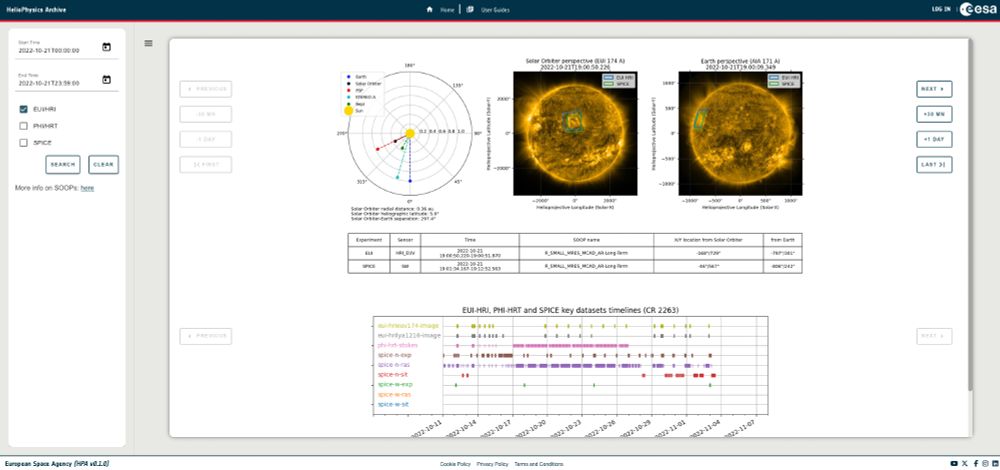
June 5, 2025 at 11:27 AM
This is a new tool to look at @science.esa.int #SolarOrbiter imaging data (or data from other missions) and the field of views of different instruments.
hpa.esa.int/hpa/#/home
hpa.esa.int/hpa/#/home
Reposted by Christian Möstl
This morning we drove to Bozeman Pride for @zoandbehold.bsky.social to speak, then went down to Yellowstone and saw incredible sights.
Then, on the drive back to Missoula at 1AM, the heavens erupted.
Naked eye visible aurora. The northern lights told us Happy Pride :)
Then, on the drive back to Missoula at 1AM, the heavens erupted.
Naked eye visible aurora. The northern lights told us Happy Pride :)

June 1, 2025 at 9:07 AM
This morning we drove to Bozeman Pride for @zoandbehold.bsky.social to speak, then went down to Yellowstone and saw incredible sights.
Then, on the drive back to Missoula at 1AM, the heavens erupted.
Naked eye visible aurora. The northern lights told us Happy Pride :)
Then, on the drive back to Missoula at 1AM, the heavens erupted.
Naked eye visible aurora. The northern lights told us Happy Pride :)
Unprocessed Level 0 data from @punch-mission.bsky.social are now available at: punch.space.swri.edu/punch_scienc...
code tools: github.com/punch-missio...
documentation:
punchbowl.readthedocs.io/en/latest/
code tools: github.com/punch-missio...
documentation:
punchbowl.readthedocs.io/en/latest/
May 21, 2025 at 12:27 PM
Unprocessed Level 0 data from @punch-mission.bsky.social are now available at: punch.space.swri.edu/punch_scienc...
code tools: github.com/punch-missio...
documentation:
punchbowl.readthedocs.io/en/latest/
code tools: github.com/punch-missio...
documentation:
punchbowl.readthedocs.io/en/latest/
The @egu.eu General Assembly week in #Vienna 🇦🇹 May 3-8 2026 may overlap with the @eurovision.tv Song Contest 2026 week! Could be more likely though that the #ESC happens one week later, with the final on Saturday May 16.
If the #ESC goes to #Graz, visitors @aswogeosphere.bsky.social are welcome! 😀
If the #ESC goes to #Graz, visitors @aswogeosphere.bsky.social are welcome! 😀
May 20, 2025 at 7:58 AM
The @egu.eu General Assembly week in #Vienna 🇦🇹 May 3-8 2026 may overlap with the @eurovision.tv Song Contest 2026 week! Could be more likely though that the #ESC happens one week later, with the final on Saturday May 16.
If the #ESC goes to #Graz, visitors @aswogeosphere.bsky.social are welcome! 😀
If the #ESC goes to #Graz, visitors @aswogeosphere.bsky.social are welcome! 😀
Theoretically the special theory of relativity was invented in Switzerland 🇨🇭 😆 - when at an @issibern.ch teams meeting, pay a visit to the Einstein Haus in downtown Bern, where he lived in 1905 when he invented special relativity!
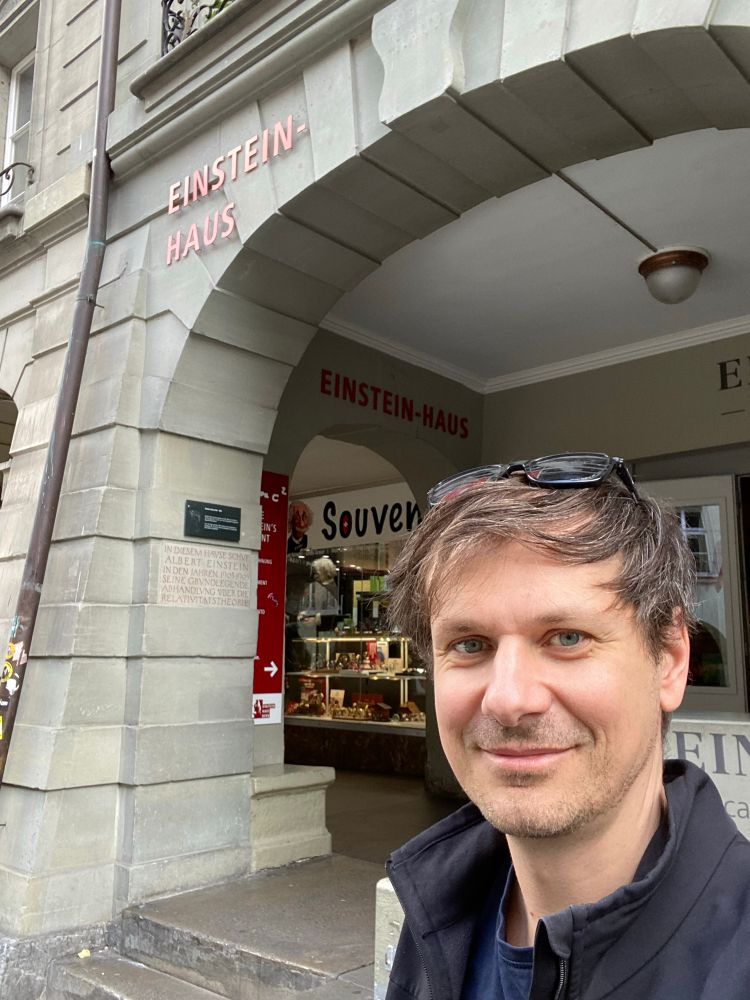



May 15, 2025 at 2:43 PM
Theoretically the special theory of relativity was invented in Switzerland 🇨🇭 😆 - when at an @issibern.ch teams meeting, pay a visit to the Einstein Haus in downtown Bern, where he lived in 1905 when he invented special relativity!
Reposted by Christian Möstl
Tomorrow is the anniversary of the 10-11 May 2024 geomagnetic superstorm! Our paper in @agu.org Space Weather led by Eva Weiler demonstrates the solar source of 5 interacting #solarstorms and the possibility to better predict such events with sub-L1 monitors in the future.
🧵👇
doi.org/10.1029/2024...
🧵👇
doi.org/10.1029/2024...


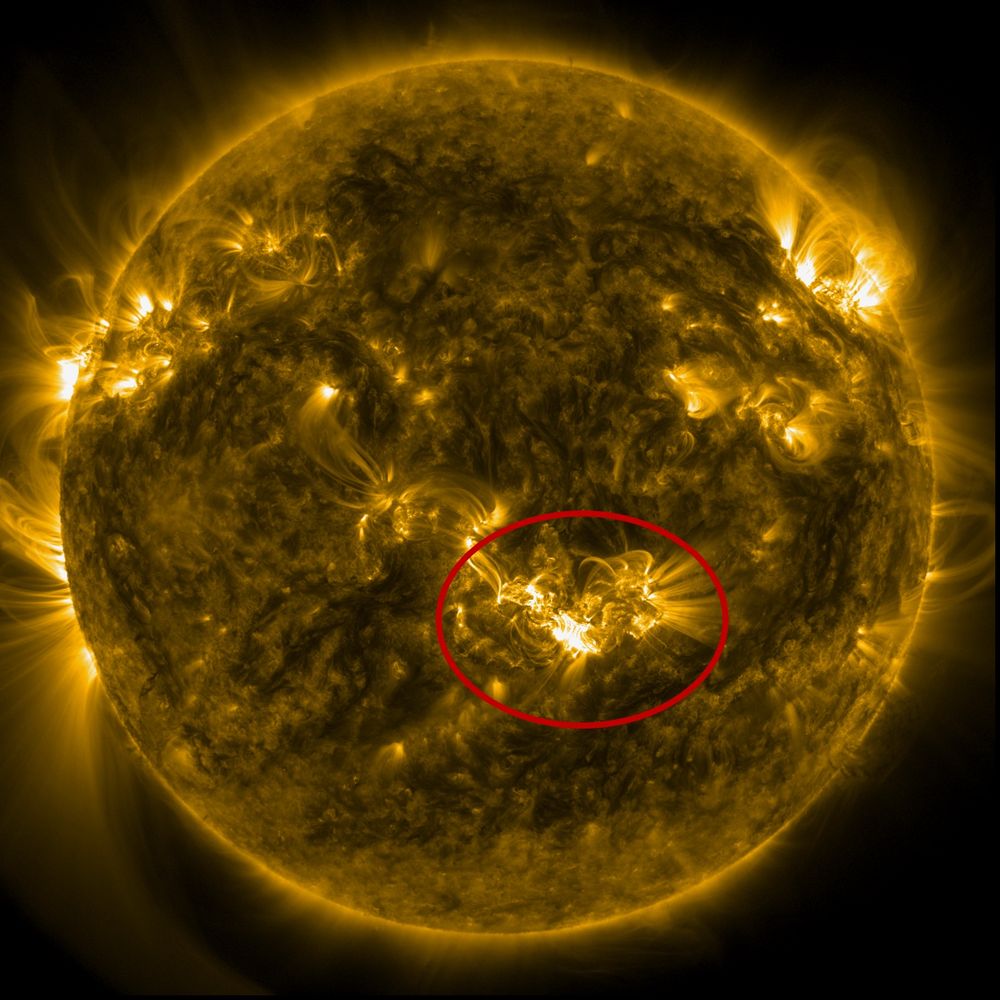
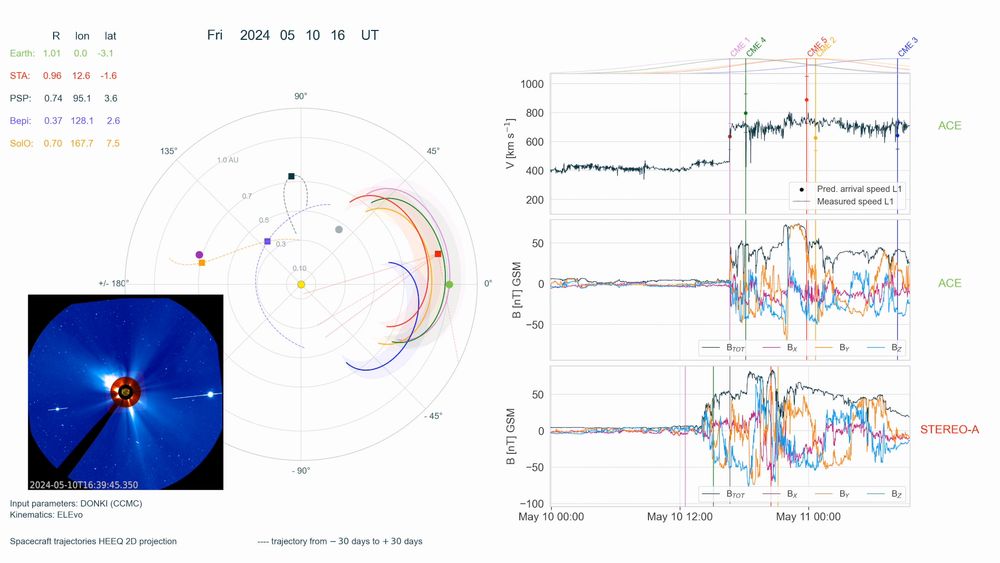
May 9, 2025 at 8:06 AM
Tomorrow is the anniversary of the 10-11 May 2024 geomagnetic superstorm! Our paper in @agu.org Space Weather led by Eva Weiler demonstrates the solar source of 5 interacting #solarstorms and the possibility to better predict such events with sub-L1 monitors in the future.
🧵👇
doi.org/10.1029/2024...
🧵👇
doi.org/10.1029/2024...
The University of Helsinki has put this introductory course on "Sustainable Space" online, covering topics such as #spacedebris, #spaceweather, #solarwind, magnetosphere, and ionosphere, atmosphere, as well as basics of satellites, orbits, and launchers.
courses.mooc.fi/org/uh-physi...
courses.mooc.fi/org/uh-physi...
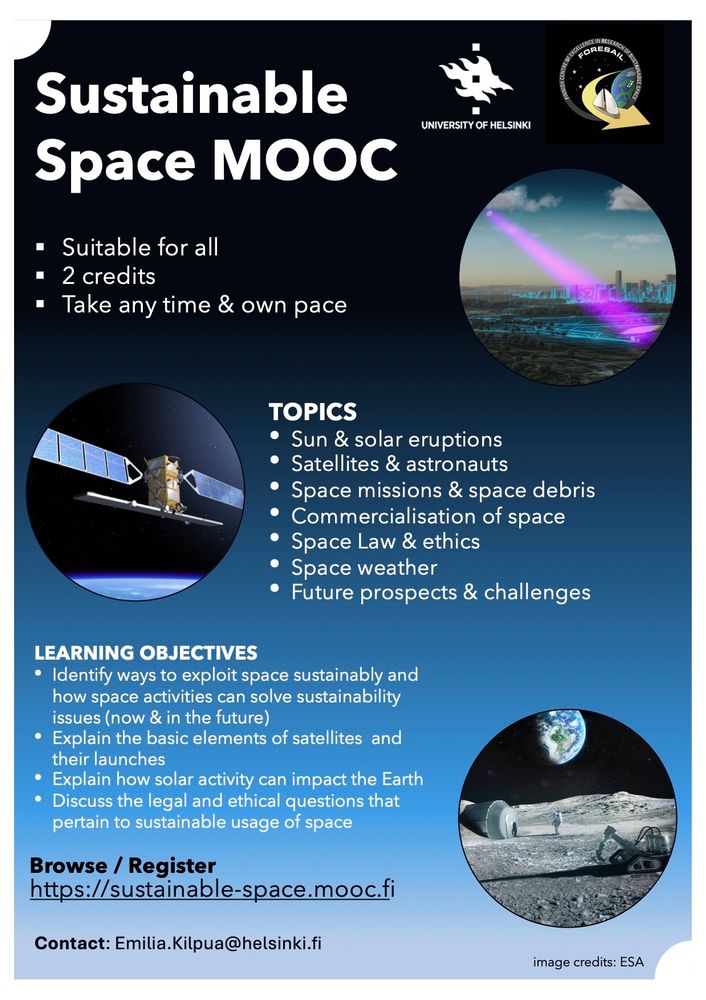
May 6, 2025 at 12:34 PM
The University of Helsinki has put this introductory course on "Sustainable Space" online, covering topics such as #spacedebris, #spaceweather, #solarwind, magnetosphere, and ionosphere, atmosphere, as well as basics of satellites, orbits, and launchers.
courses.mooc.fi/org/uh-physi...
courses.mooc.fi/org/uh-physi...
At #EGU2025 I talked today about our catalogs for #solastorm observations and how they are used for enhancing #spaceweather forecasting. Plus gave a quick outlook of how data of the new PUNCH @punch-mission.bsky.social mission can be used in connection with many other spacecraft in the heliosphere!
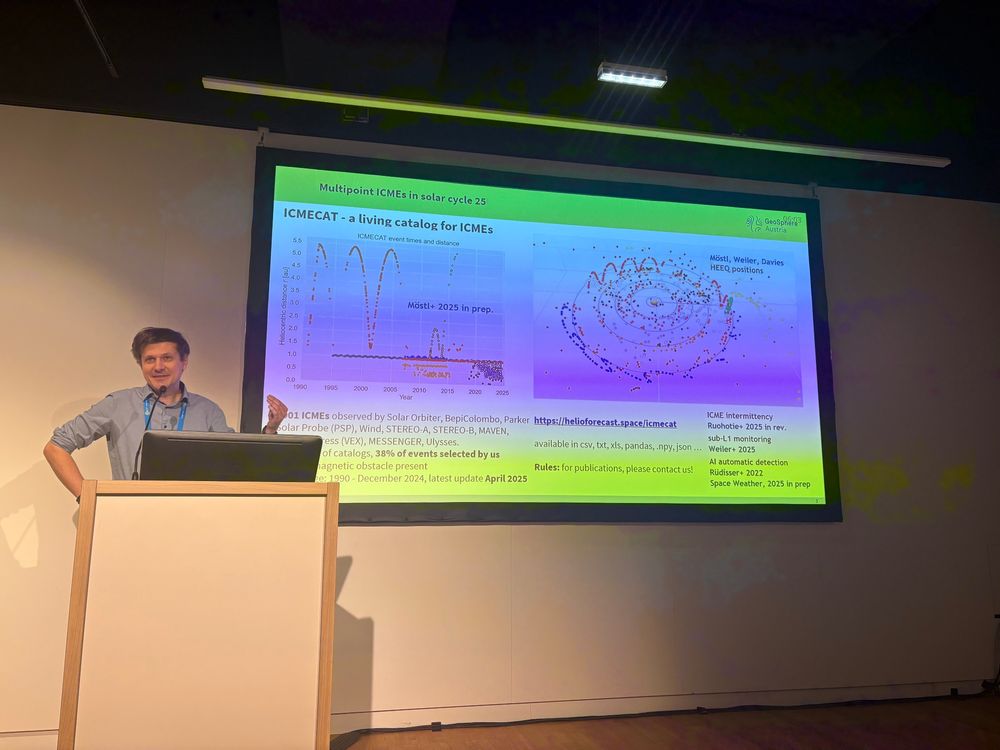
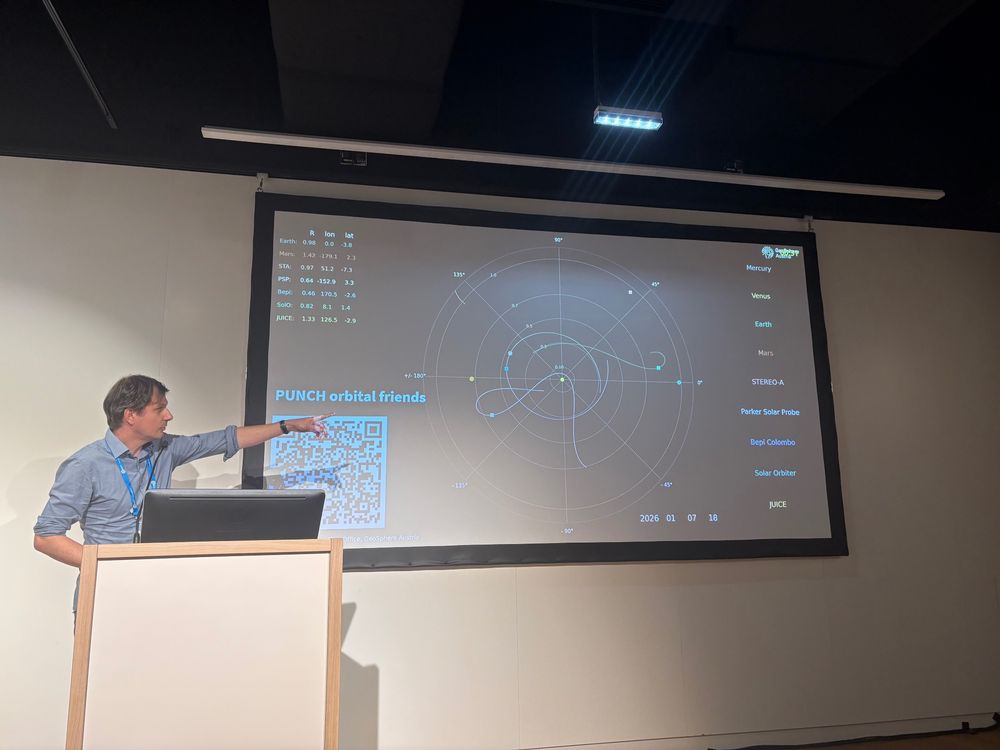
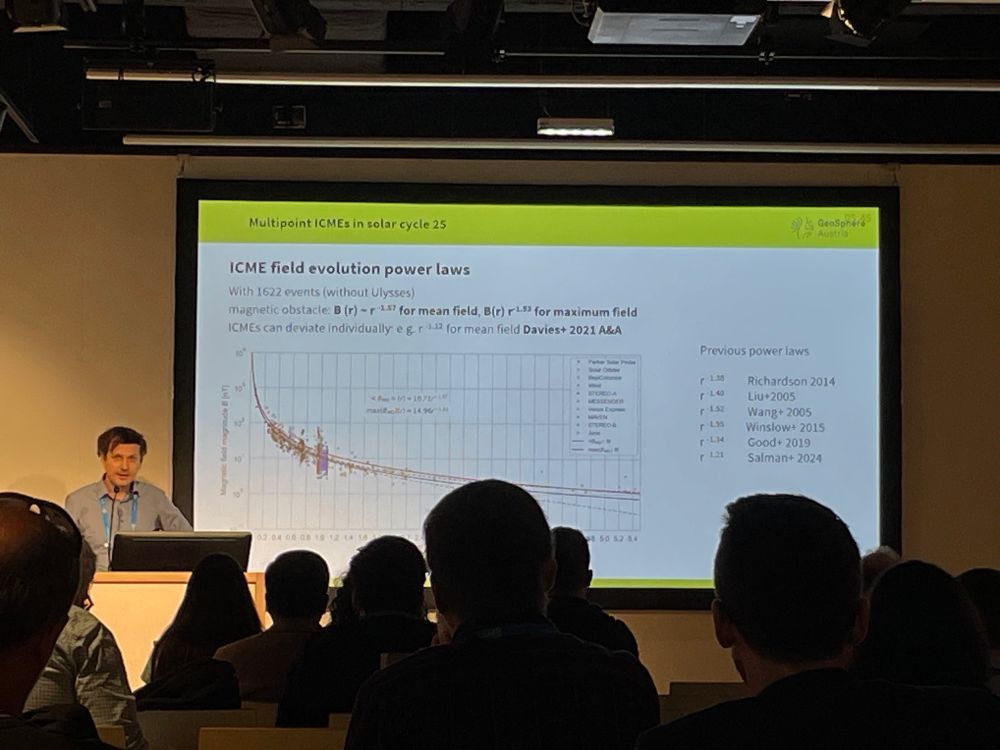
May 1, 2025 at 9:37 AM
At #EGU2025 I talked today about our catalogs for #solastorm observations and how they are used for enhancing #spaceweather forecasting. Plus gave a quick outlook of how data of the new PUNCH @punch-mission.bsky.social mission can be used in connection with many other spacecraft in the heliosphere!
Say 👋 and meet our team at #EGU25!
Our team at the Austrian Space Weather Office has 5 presentations as lead-author at this weeks #EGU25 in Vienna, and we (co-)convene 3 sessions!
We show our work on forecasting #solarstorms and observations with multiple spacecraft, using #AI methods for their detection and #solarwind modeling! ☀️💥
We show our work on forecasting #solarstorms and observations with multiple spacecraft, using #AI methods for their detection and #solarwind modeling! ☀️💥
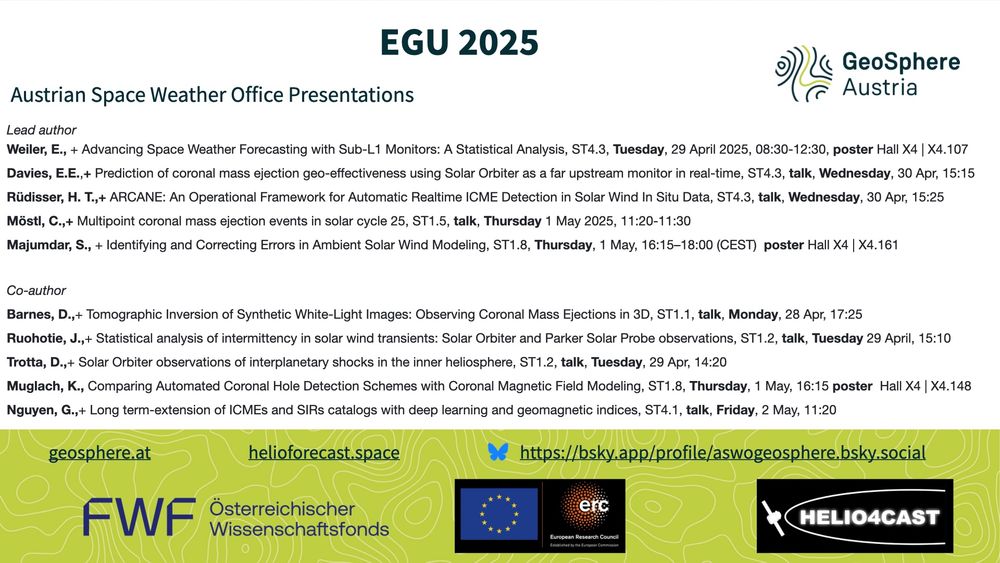
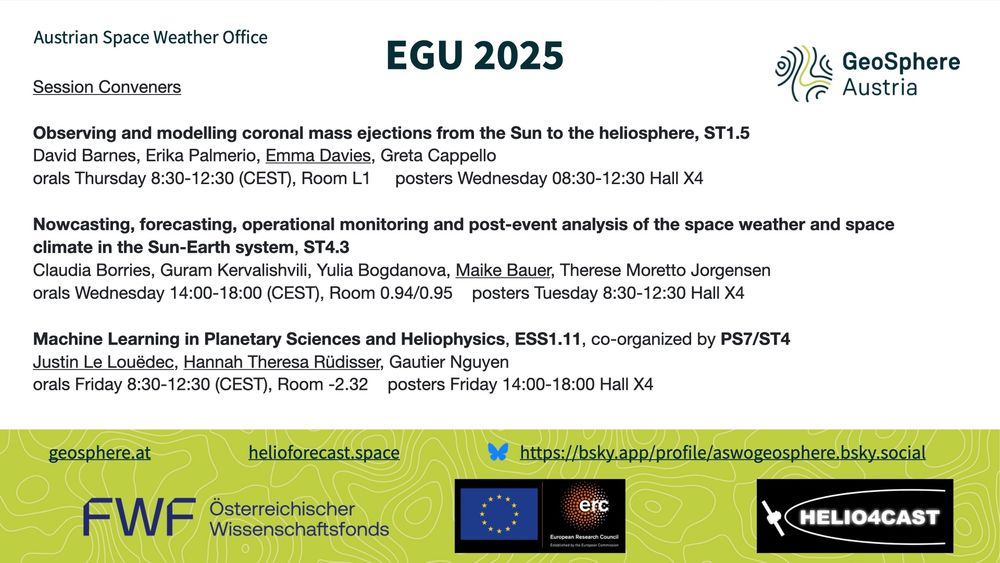
April 28, 2025 at 8:00 AM
Say 👋 and meet our team at #EGU25!


